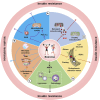Potential molecular mechanism of exercise reversing insulin resistance and improving neurodegenerative diseases
- PMID: 38818523
- PMCID: PMC11137309
- DOI: 10.3389/fphys.2024.1337442
Potential molecular mechanism of exercise reversing insulin resistance and improving neurodegenerative diseases
Abstract
Neurodegenerative diseases are debilitating nervous system disorders attributed to various conditions such as body aging, gene mutations, genetic factors, and immune system disorders. Prominent neurodegenerative diseases include Alzheimer's disease, Parkinson's disease, Huntington's disease, amyotrophic lateral sclerosis, and multiple sclerosis. Insulin resistance refers to the inability of the peripheral and central tissues of the body to respond to insulin and effectively regulate blood sugar levels. Insulin resistance has been observed in various neurodegenerative diseases and has been suggested to induce the occurrence, development, and exacerbation of neurodegenerative diseases. Furthermore, an increasing number of studies have suggested that reversing insulin resistance may be a critical intervention for the treatment of neurodegenerative diseases. Among the numerous measures available to improve insulin sensitivity, exercise is a widely accepted strategy due to its convenience, affordability, and significant impact on increasing insulin sensitivity. This review examines the association between neurodegenerative diseases and insulin resistance and highlights the molecular mechanisms by which exercise can reverse insulin resistance under these conditions. The focus was on regulating insulin resistance through exercise and providing practical ideas and suggestions for future research focused on exercise-induced insulin sensitivity in the context of neurodegenerative diseases.
Keywords: Parkinson’s disease; alzheimer’s disease; amyotrophic lateral sclerosis; exercise; huntington’s disease; insulin resistance; multiple sclerosis.
Copyright © 2024 Shen, Wang, Wang and Zhang.
Conflict of interest statement
The authors declare that the research was conducted in the absence of any commercial or financial relationships that could be construed as a potential conflict of interest.
Figures



Similar articles
-
Effects of exercise on sleep in neurodegenerative disease.Neurobiol Dis. 2020 Jul;140:104859. doi: 10.1016/j.nbd.2020.104859. Epub 2020 Apr 1. Neurobiol Dis. 2020. PMID: 32243913 Free PMC article. Review.
-
Unraveling Molecular and Genetic Insights into Neurodegenerative Diseases: Advances in Understanding Alzheimer's, Parkinson's, and Huntington's Diseases and Amyotrophic Lateral Sclerosis.Int J Mol Sci. 2023 Jun 28;24(13):10809. doi: 10.3390/ijms241310809. Int J Mol Sci. 2023. PMID: 37445986 Free PMC article. Review.
-
Mitochondrial dysfunction and oxidative stress in Alzheimer's disease, and Parkinson's disease, Huntington's disease and Amyotrophic Lateral Sclerosis -An updated review.Mitochondrion. 2023 Jul;71:83-92. doi: 10.1016/j.mito.2023.05.007. Epub 2023 Jun 1. Mitochondrion. 2023. PMID: 37269968 Review.
-
Common Factors in Neurodegeneration: A Meta-Study Revealing Shared Patterns on a Multi-Omics Scale.Cells. 2020 Dec 8;9(12):2642. doi: 10.3390/cells9122642. Cells. 2020. PMID: 33302607 Free PMC article.
-
Multi-omics studies reveal ameliorating effects of physical exercise on neurodegenerative diseases.Front Aging Neurosci. 2022 Oct 31;14:1026688. doi: 10.3389/fnagi.2022.1026688. eCollection 2022. Front Aging Neurosci. 2022. PMID: 36389059 Free PMC article. Review.
Cited by
-
Depression and Plasma pTau181 Levels Are Associated with Frailty Status in Hispanic Community-Dwelling Older Women.Gerontol Geriatr Med. 2024 Sep 27;10:23337214241283546. doi: 10.1177/23337214241283546. eCollection 2024 Jan-Dec. Gerontol Geriatr Med. 2024. PMID: 39359650 Free PMC article.
-
The interplay between physical exercise and autophagy signaling in brain health, neurodegenerative diseases and aging.Front Aging Neurosci. 2025 Jul 29;17:1579208. doi: 10.3389/fnagi.2025.1579208. eCollection 2025. Front Aging Neurosci. 2025. PMID: 40799366 Free PMC article. Review.
-
Role of Peripheral and Central Insulin Resistance in Neuropsychiatric Disorders.J Clin Med. 2024 Nov 3;13(21):6607. doi: 10.3390/jcm13216607. J Clin Med. 2024. PMID: 39518747 Free PMC article. Review.
-
Exercise orchestrates systemic metabolic and neuroimmune homeostasis via the brain-muscle-liver axis to slow down aging and neurodegeneration: a narrative review.Eur J Med Res. 2025 Jun 12;30(1):475. doi: 10.1186/s40001-025-02751-9. Eur J Med Res. 2025. PMID: 40506775 Free PMC article. Review.
-
New perspectives on molecular mechanisms underlying exercise-induced benefits in Parkinson's disease.NPJ Parkinsons Dis. 2025 Aug 23;11(1):256. doi: 10.1038/s41531-025-01113-w. NPJ Parkinsons Dis. 2025. PMID: 40849310 Free PMC article. Review.
References
Publication types
LinkOut - more resources
Full Text Sources

